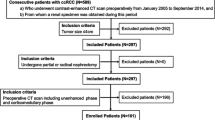Abstract
Background
CT and MRI are both used for abdominal staging of pediatric renal tumors. The diagnostic performance of the two modalities for local and regional staging of renal tumors has not been systematically evaluated.
Objective
To compare the diagnostic performance of CT and MRI for local staging of pediatric renal tumors.
Materials and methods
The study population was derived from the AREN03B2 study of the Children’s Oncology Group. Baseline abdominal imaging performed with both CT and MRI within 30 days of nephrectomy was available for retrospective review in 82 renal tumor cases. Each case was evaluated for capsular penetration, lymph node metastasis, tumor thrombus, preoperative tumor rupture, and synchronous contralateral lesions. The surgical and pathological findings at central review were the reference standard.
Results
The sensitivity of CT and MRI for detecting capsular penetration was 68.6% and 62.9%, respectively (P = 0.73), while specificity was 86.5% and 83.8% (P = 1.0). The sensitivity of CT and MRI for detecting lymph node metastasis was 76.5% and 52.9% (P = 0.22), and specificity was 90.4% and 92.3% (P = 1.0). Synchronous contralateral lesions were identified by CT in 4/9 cases and by MRI in 7/9 cases.
Conclusion
CT and MRI have similar diagnostic performance for detection of lymph node metastasis and capsular penetration. MR detected more contralateral synchronous lesions; however these were present in a very small number of cases. Either modality can be used for initial loco–regional staging of pediatric renal tumors.



Similar content being viewed by others
References
Brisse HJ, Smets AM, Kaste SC et al (2008) Imaging in unilateral Wilms tumour. Pediatr Radiol 38:18–29
Riccabona M (2003) Imaging of renal tumours in infancy and childhood. Eur Radiol 4:L116–L129
Simanovsky N, Hiller N (2007) Importance of sonographic detection of enlarged abdominal lymph nodes in children. J Ultrasound Med 26:581–584
Khanna G, Rosen N, Anderson JR et al (2012) Evaluation of diagnostic performance of CT for detection of tumor thrombus in children with Wilms tumor: a report from the Children’s Oncology Group. Pediatr Blood Cancer 58:551–555
Khanna G, Naranjo A, Hoffer F et al (2013) Detection of preoperative wilms tumor rupture with CT: a report from the Children’s Oncology Group. Radiology 266:610–617
Rohrschneider WK, Weirich A, Rieden K et al (1998) US, CT and MR imaging characteristics of nephroblastomatosis. Pediatr Radiol 28:435–443
Newcombe RG (1998) Two-sided confidence intervals for the single proportion: comparison of seven methods. Stat Med 17:857–872
Kaste SC, Dome JS, Babyn PS et al (2008) Wilms tumour: prognostic factors, staging, therapy and late effects. Pediatr Radiol 38:2–17
Shamberger RC, Guthrie KA, Ritchey ML et al (1999) Surgery-related factors and local recurrence of Wilms tumor in National Wilms Tumor Study 4. Ann Surg 229:292–297
Gow KW, Roberts IF, Jamieson DH et al (2000) Local staging of Wilms’ tumor — computerized tomography correlation with histological findings. J Pediatr Surg 35:677–679
McDonald K, Duffy P, Chowdhury T et al (2013) Added value of abdominal crosssectional imaging (CT or MRI) in staging of Wilms' tumours. Clin Radiol 68:16–20
Cauldwell C (2011) Anesthesia risks associated with pediatric imaging. Pediatr Radiol 41:949–950
Ehrlich PF, Anderson JR, Ritchey ML et al (2013) Clinicopathologic findings predictive of relapse in children with stage III favorable-histology Wilms tumor. J Clin Oncol 31:1196–1201
Ritchey ML, Shamberger RC, Hamilton T et al (2005) Fate of bilateral renal lesions missed on preoperative imaging: a report from the National Wilms Tumor Study Group. J Urol 174:1519–1521, discussion 1521
Acknowledgments
Research was supported by grants U10 CA98543 and U10 CA98413 from the National Institutes of Health to the Children’s Oncology Group, and by grant CA29511 from the National Institutes of Health to the Quality Assurance Review Center (QARC).
Conflicts of interest
None
Author information
Authors and Affiliations
Corresponding author
Rights and permissions
About this article
Cite this article
Servaes, S., Khanna, G., Naranjo, A. et al. Comparison of diagnostic performance of CT and MRI for abdominal staging of pediatric renal tumors: a report from the Children’s Oncology Group. Pediatr Radiol 45, 166–172 (2015). https://doi.org/10.1007/s00247-014-3138-2
Received:
Revised:
Accepted:
Published:
Issue Date:
DOI: https://doi.org/10.1007/s00247-014-3138-2




